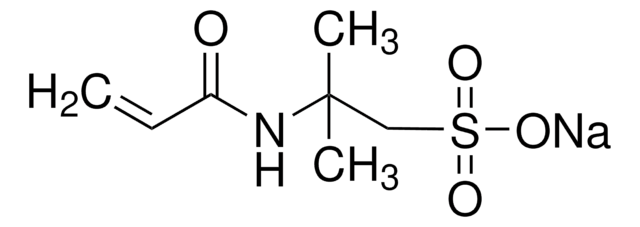448281
(3-Acrylamidopropyl)trimethylammonium chloride solution
75 wt. % in H2O
Synonym(s):
(Acrylamidopropyl)trimethylammonium chloride, Acryloylaminopropyltrimethylammonium chloride, Trimethyl(3-acrylamidopropyl)ammonium chloride
About This Item
Recommended Products
contains
3,000 ppm monomethyl ether hydroquinone as stabilizer
concentration
75 wt. % in H2O
refractive index
n20/D 1.4848
density
1.11 g/mL at 25 °C
storage temp.
2-8°C
SMILES string
[Cl-].C[N+](C)(C)CCCNC(=O)C=C
InChI
1S/C9H18N2O.ClH/c1-5-9(12)10-7-6-8-11(2,3)4;/h5H,1,6-8H2,2-4H3;1H
InChI key
OEIXGLMQZVLOQX-UHFFFAOYSA-N
Related Categories
General description
Application
- As a cationic monomer to synthesize polyampholyte hydrogels (PAHs). These hydrogels show pH-responsive and ionic strength-responsive behavior and are suitable for application in smart coatings and biosensors.
- As a monomer to prepare poly(APTAC) ion exchange membranes with high surface porosity, for the removal of Cu(II), Cr(VI), and As(V) ions from water.
- As a precursor to fabricate cartilage mimetic polymer scaffolds that can be used in cartilage regeneration and replacement.
Hazard Statements
Precautionary Statements
Hazard Classifications
Aquatic Chronic 3
Storage Class Code
10 - Combustible liquids
WGK
WGK 1
Flash Point(F)
Not applicable
Flash Point(C)
Not applicable
Certificates of Analysis (COA)
Search for Certificates of Analysis (COA) by entering the products Lot/Batch Number. Lot and Batch Numbers can be found on a product’s label following the words ‘Lot’ or ‘Batch’.
Already Own This Product?
Find documentation for the products that you have recently purchased in the Document Library.
Customers Also Viewed
Our team of scientists has experience in all areas of research including Life Science, Material Science, Chemical Synthesis, Chromatography, Analytical and many others.
Contact Technical Service![[2-(Acryloyloxy)ethyl]trimethylammonium chloride solution 80 wt. % in H2O, contains 600 ppm monomethyl ether hydroquinone as inhibitor](/deepweb/assets/sigmaaldrich/product/structures/393/326/f7e19585-5431-4220-81b5-f458de6d63d0/640/f7e19585-5431-4220-81b5-f458de6d63d0.png)
![[2-(Methacryloyloxy)ethyl]trimethylammonium chloride solution 75 wt. % in H2O](/deepweb/assets/sigmaaldrich/product/structures/316/612/66b0f4cf-d060-427d-b4f5-e8fab3e5cffe/640/66b0f4cf-d060-427d-b4f5-e8fab3e5cffe.png)
![[3-(Methacryloylamino)propyl]trimethylammonium chloride solution 50 wt. % in H2O](/deepweb/assets/sigmaaldrich/product/structures/189/736/089bc8ae-2a98-416d-9f9a-a0a510b6b828/640/089bc8ae-2a98-416d-9f9a-a0a510b6b828.png)


![[2-(Methacryloyloxy)ethyl]dimethyl-(3-sulfopropyl)ammonium hydroxide 95%](/deepweb/assets/sigmaaldrich/product/structures/217/219/73c91e1c-0ee4-4b3d-bead-a6dc3d09d1da/640/73c91e1c-0ee4-4b3d-bead-a6dc3d09d1da.png)









![N-[Tris(hydroxymethyl)methyl]acrylamide contains ≤7% KCl, 93%](/deepweb/assets/sigmaaldrich/product/structures/130/961/5bc6d1a4-a540-4496-9f46-74507af67e21/640/5bc6d1a4-a540-4496-9f46-74507af67e21.png)